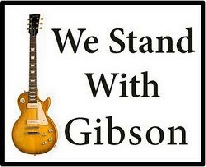


they began marketing a mass produced electrically amplified, pedaless, lap steel
Hawaiian Guitar. The Ro-
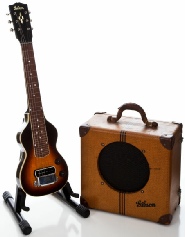
Gibson’s First Electric Guitars
As the music scene continued to evolve into the Jazz Band Era, the market shifted
once again from the tenor banjo to the Spanish style guitar. In order to compete
with the volume of the large horn sections of the Jazz Era, Gibson started developing
larger archtop acoustic guitars such as the Advanced L 5 and the Super 400 series.
These instruments were successful, but in 1931, The Ro-
needed to expand, Orville sold his patent and the rights to his name to a group of
investors from Kalamazoo in 1902. At that point, Orville unknowingly lost control
of the business. It is reported that Orville Gibson received $2,500.00 and a small
number of shares in the newly created company. Unable to effectively deal with the
new board of directors, Orville liquidated his stock in 1903. He kept working for
the company as a consultant until 1904. When Orville retired, The Gibson Mandolin-
Gibson Enters The Guitar Market
Capitalizing on Orville’s designs, The Gibson Mandolin-
Orville Gibson, the company’s founder and namesake was born in Chateauguay, New York
in 1856. Later moving to Kalamazoo, Michigan, he started building mandolins in his
small one room wood shop. An accomplished professional musician who was working as
a restaurant clerk full time, Orville began to experiment with mandolin designs in
his spare time. The sound boards and backs of the mandolins produced at that time
were press-
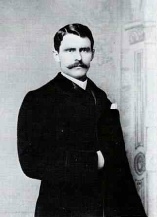
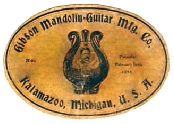
instrument business full time. He patented his carved design in 1898; this was his only instrument patent. Orville Gibson’s reputation for producing high quality instruments grew rapidly and soon Gibson Mandolins dominated the mandolin market. Gibson received so many orders for mandolins that his production couldn’t keep up with demand. Because he couldn’t raise the capital
out of one thick piece of wood. After successfully building superior mandolins using his violin inspired carved sound boards and backs, Orville then started designing and producing banjos, lutes and guitars with carved sound boards and backs. He began selling his instruments in 1894 and two years later he was able to quit his day time job and go into the
during this time period that Gibson luthier Ted McHugh designed both the Truss Rod and the adjustable height bridge. The market shifted to tenor banjos and demand for mandolins bottomed out. Gibson, whose primary source of revenue was from mandolin sales, went into rapid economic decline.
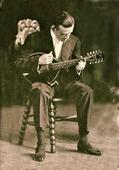
these units would eventually become successful, but were immediate marketing failures and Loar’s efforts did not pull Gibson out of its economic trouble. Because of this failed effort, Loar (who would later be regarded as legendary) resigned and left the company in 1924.
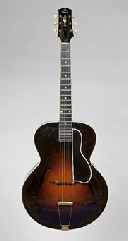
Nationally renowned mandolinist and composer Lloyd Loar had joined the company in 1919 as an acoustics engineer. In 1922, Loar designed the innovative F 5 mandolin and the L 5 archtop guitar in a desperate attempt to revive sales. Both of
Gibson Guitar History
Gibson Guitars are truly American Guitars. Gibson Guitars are designed and built
by highly skilled American luthiers, sound engineers and musicians. The Gibson Guitar
Corporation also owns and operates Epiphone, Baldwin, Wurlitzer, Slingerland Drums,
Steinberger and Oberheim Electronics. First incorporated in 1902 as The Gibson Mandolin-
Orville Gibson

In 1954, Ted McCarty invented and produced the Tune-
a major advancement in magnetic pickup design and is widely used today.
Gibson Acquires Epiphone
In 1957, McCarty was able to convince CMI to purchase longtime rival Epiphone Incorporated. Epiphone had been in a state of disarray since the death of company president Epimanondas Stathopoulo in 1943 and was facing certain economic collapse. McCarty only wanted Epiphone’s bass guitar production equipment, but parent company CMI saw the acquisition of Epiphone as an opportunity to increase Gibson’s dealer base. Epiphone was reorganized and in 1959 a new line of Epiphone instruments were released. Epiphone would eventually be used to market an import line of Gibson Guitars.
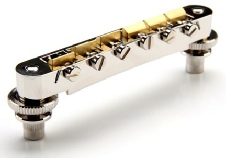
The Humbucker And The Tune-O-Matic Bridge
by Chicago Musical Instruments (CMI) and instrument production resumed. Engineer
Ted McCarty, (who served as company president from 1950 until 1966) was hired in
1948. McCarty’s leadership guided Gibson to a steady expansion which resulted in
a 15% increase in sales revenue and the addition of over one thousand highly skilled
employees. Ted McCarty was a man of vision and is directly responsible for the invention
of the intonation adjustable Tune-
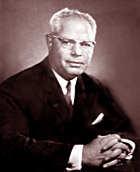
When the United States entered World War Two, quality wood materials needed for instrument production were unavailable, so the Gibson Guitar Factory cut instrument production and began manufacturing items needed for the war effort. In 1944, as the war was ending, Gibson was purchased
Shortly after McCarty was promoted to company president in 1950, Gibson Guitars changed direction and began to concentrate their design efforts toward the rapidly emerging electric guitar market. Taking note of the commercial success of Leo Fender’s solid body Telecaster, which was released in 1951, McCarty’s research and development team began developing
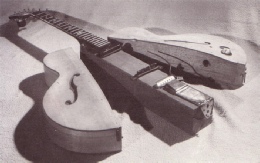
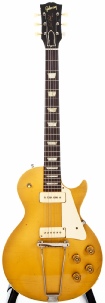
their own solid body electric guitar. This guitar would prove to be the most successful and recognizable electric guitar ever produced by any instrument company. McCarty’s version of the solid body was much more than a flat piece of wood with a neck bolted on it. The Gibson Engineers designed a solid body carved archtop unit that combined Maple and Mahogany in the body construction. Maple was used on the top and Mahogany on the back. This had never been done before, and the softer fullness of the mahogany combined with the harder, brighter clarity of the Maple gave the new solid body a unique sound. For marketing purposes, McCarty enlisted the endorsement of popular guitarist and recording artist Les Paul. Les Paul, who had been endorsing Gibson Guitars since 1928, had unsuccessfully been trying to convince Gibson to produce a solid body electric guitar since his “Log” solid body experiment in 1941. Under McCarty’s direction The Gibson Les Paul Model was introduced in 1952 and the rest is history.
Gibson’s First Solid Body Electric Guitar; The Les Paul
the Slingerland Drum Company, the Flatiron Mandolin Company, Garrison Guitars and the Baldwin Piano and Organ Company. Gibson also moved into the lucrative lower priced import guitar market with the Epiphone line. In 2002, the Gibson Digital Guitar and the Robot Guitar
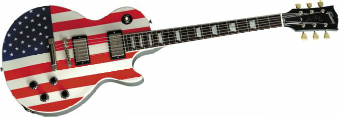
were released. In 2003, a new Epiphone Factory was built in China and Gibson’s new European distribution facility opened. In spite of the changes in the music industry, fluctuations in the economy and multi management
changes, Gibson is strong. With American Ingenuity, American Spirit and American Technicians, Gibson is back on top, producing high quality American Gibson Guitars.
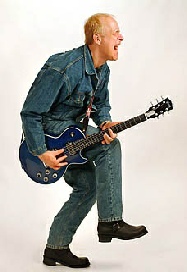
The Gibson Guitar Factory was put on the market and was purchased in 1986 for five million dollars by guitar enthusiast Henry Juszkiewicz and David Berryman. Using his musical knowledge and a MBA from Harvard, Juszkiewicz quickly reversed Gibson’s rapid decline by changing management personnel and marketing reissues of its classic guitar models.
After Juszkiewicz and Berryman took control, Gibson consistently saw an annual compound growth rate in the 30% range and is still strong today. Gibson increased its holdings by acquiring Steinberger Guitars, Oberheim Corporation, the Tobias Bass Company,
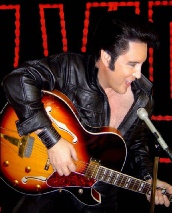
The End Of The McCarty Era
Under McCarty’s guidance, Gibson Guitar’s success continued, with the company’s instruments
being used by many notable musicians in every music venue. Gibson was selling over
100,000 guitars annually by the mid-
beer company to form a new company called Norlin. This merger, combined with the loss of the innovative McCarty, was a devastating blow to Gibson Guitars. Under the control of Norlin, sales dropped drastically. In 1983, Norlin became Rooney Pace and Piezo Electric Products Incorporated.
Henry Juszkiewicz Revives Gibson
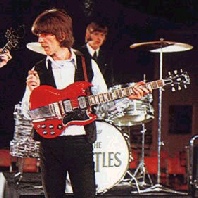
In 1961, because of the popularity of the double cutaway design, Gibson developed a double cutaway version of the Les Paul solid body. To promote this new instrument, Ted McCarty sought the endorsement of Les Paul, who didn’t care for the design and refused to cooperate. The new guitar was then renamed the Gibson SG, which stood for solid guitar. The SG was a commercial success and is still in production by both Gibson and Epiphone.
The Gibson SG
Also in 1958, Gibson introduced four new innovative electric guitars, three of which
were not immediately successful. The Flying V, The Moderne and The Explorer failed
commercially at the time of their release. These instruments were definitely ahead
of their time, as they were re-
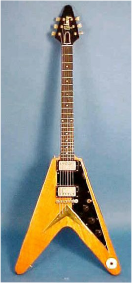
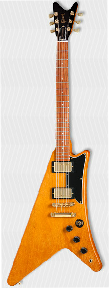
Ted McCarty’s own creation, the ES 335 Dot was a major development in electric guitar design. The ES 335 guitar contained a carved Maple wood block approximately six inches wide, which was attached at the neck joint and extended the full length of the body. The Dot, in theory, is a combination of Les Paul’s Log experiment and Rickenbacker’s neck through design, where the neck and bridge are attached to one continuous piece of wood. The Maple top, sides and back provide two separate sealed sound chambers with F holes, giving the instrument the hit and sustain of a solid body and the tonal influences of a hollow body. The ES 335 Dot was very well received by the Jazz and Blues players at the time of its release. Like McCarty’s other inventions, the Tune O Matic Bridge and the Stop Bar Tailpiece, the Gibson ES 335 Dot has found its place in history. It is still in production and continues to be popular. It is the instrument of choice for many noted Jazz, Blues, Country and Western, and Rock and Roll musicians.
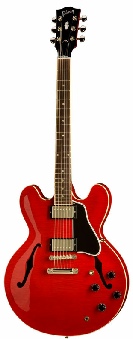
The Gibson ES 335 Dot; The First Semi Hollow Body Electric Guitar
